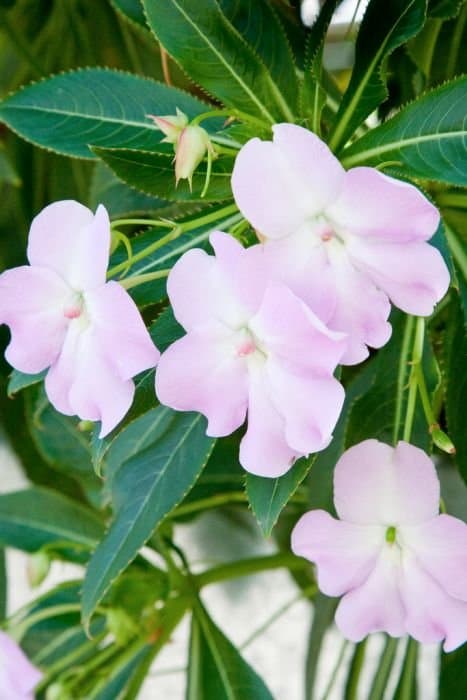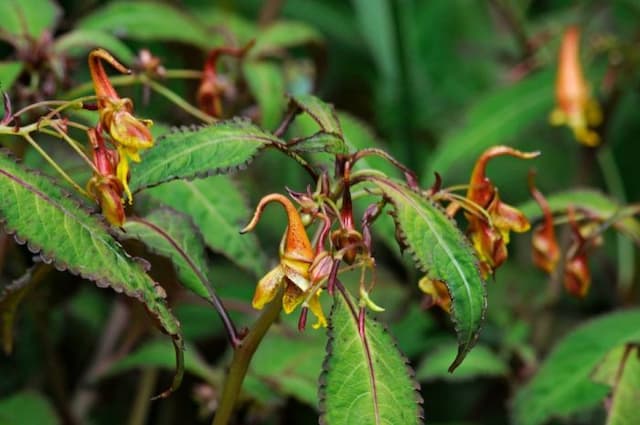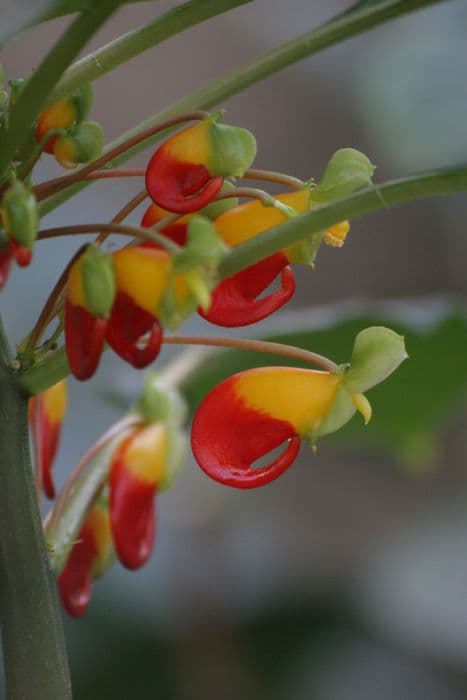Busy lizzie [SunPatiens Vigorous Magenta] Impatiens Sunpatiens Vigorous Magenta = 'Misato Fg3' (Sunpatiens Series) (NG)
![busy lizzie [SunPatiens Vigorous Magenta]](/_next/image?url=https%3A%2F%2Fplants-admin.emdemapps.com%2Fimages%2Fplants%2F%2Fimages%2F604b622adf631.png&w=3840&q=75)
ABOUT
[SunPatiens Vigorous Magenta] is a vigorous, bushy perennial, to 60cm or more in height, usually grown as an annual. Dark green leaves have tapering tips and toothed margins. Flowers are bright-pink to magenta, 3-5cm wide and produced in profusion in summer
About this plant
 Names
NamesSynonyms
Sunpatiens, Busy Lizzie, New Guinea Impatiens, Balsam, Sultana, Patient Lucy.
Common names
Impatiens Sunpatiens Vigorous Magenta = 'Misato Fg3' (Sunpatiens Series) (NG)
 Characteristics
CharacteristicsLife cycle
Annuals
Foliage type
Evergreen
Color of leaves
Green
Flower color
Magenta
Height
2 feet 24-36 inches (60-91 cm)
Spread
2 feet 24-36 inches (60-91 cm)
Plant type
Herb
Hardiness zones
10
Native area
Asia
Benefits
 General Benefits
General Benefits- Drought Tolerance: Once established, it can withstand periods without water, making it suitable for a variety of climates.
- Heat Resistance: This variety can thrive in hot conditions where other impatiens might struggle.
- Continuous Blooming: Offers a long blooming period from spring to frost, providing consistent color in the garden.
- Versatility: It can be grown in mixed beds, borders, containers, and as a mass planting, making it a flexible choice for gardeners.
- Bright Color: Produces vibrant magenta flowers that can brighten up any garden space.
- Low Maintenance: Requires minimal care once established, making it ideal for busy gardeners.
- Disease Resistance: The Sunpatiens series is known for its resistance to downy mildew and other common diseases affecting impatiens.
- Rapid Growth: It grows quickly to fill in spaces, making it a good choice for adding fast color and coverage.
- Ease of Propagation: It can be easily propagated from cuttings, allowing gardeners to expand their plantings without additional cost.
- Pollinator Attraction: Attracts bees and butterflies, adding to the biodiversity and health of the garden.
 Medical Properties
Medical PropertiesThis plant is not used for medical purposes.
 Air-purifying Qualities
Air-purifying QualitiesThis plant is not specifically known for air purifying qualities.
 Other Uses
Other Uses- Impatiens Sunpatiens can be used as a natural dye source for fabrics, offering a variety of shades ranging from soft pinks to vibrant magentas depending on the mordant used.
- These plants can be incorporated into educational programs at schools or botanical gardens to teach about plant growth, hybridization, and adaptation to sunlight.
- The thick foliage of Impatiens Sunpatiens provides a modest habitat for small beneficial insects, such as ladybugs, that contribute to the ecological balance in a garden.
- As a fast-growing plant, Impatiens Sunpatiens can be used in horticultural therapy settings for projects that allow patients to see quick results, fostering a sense of achievement.
- Impatiens Sunpatiens can be utilized in art projects, such as pressing the flowers for inclusion in handmade paper or botanical prints.
- Their vibrant color and prolific nature make them a suitable choice for temporary garden installations or floral displays at public events and ceremonies.
- When grown in containers, Impatiens Sunpatiens can serve as a living screen or privacy barrier on balconies and patios.
- The plant can be used to demonstrate the process of deadheading in gardening workshops, as removing spent blooms encourages further flowering.
- In a compost heap, Impatiens Sunpatiens contribute green material rich in nitrogen, which helps to balance the carbon-rich browns and speed up the composting process.
- Their colorful appearance can be a natural way to delineate pathways or specific areas within a larger garden without the use of artificial markers.
Interesting Facts
 Feng Shui
Feng ShuiThe Sunpatiens is not used in Feng Shui practice.
 Zodiac Sign Compitability
Zodiac Sign CompitabilityThe Sunpatiens is not used in astrology practice.
 Plant Symbolism
Plant Symbolism- Patience: The common name "Impatiens" is derived from the Latin for 'impatient', referring to the seed pods that burst open when ripe. However, in the language of flowers, it symbolizes patience, possibly as an ironic nod to its name.
- Motherly Love: Impatiens are often associated with motherly love due to their nurturing growth habit and continuous blossoms, similar to a mother's enduring care.
- Affection: Featuring heart-shaped leaves, Impatiens represents affection and fondness, making it an ideal gift for loved ones.
 Water
WaterSunpatiens should be watered regularly to keep the soil moist but not soggy, especially during warmer months or in full sun locations. Typically, this means watering them roughly once every 2 to 3 days, but this can vary depending on climate conditions and the plant's environment. Each watering session should involve enough water to soak the soil around the roots, which may be around 1 to 1.5 gallons for a large plant in a garden setting. Adjust the amount and frequency as needed based on rainfall, temperature, and whether the plant is in a container or the ground.
 Light
LightSunpatiens thrive in locations with bright, indirect light or partial shade. They can tolerate full sun conditions but may require more frequent watering to prevent stress from heat. Morning sun with afternoon shade is often ideal for maintaining vibrant foliage and continuous blooming. Avoid deep shade, as this can reduce blooming and lead to leggy growth.
 Temperature
TemperatureSunpatiens prefer a temperature range of around 60°F to 85°F for optimal growth. They can survive in temperatures as low as 50°F and as high as 90°F, but prolonged exposure to temperatures outside this range may stress the plants. To ensure vigorous growth and flowering, try to maintain temperature conditions within their preferred range as much as possible.
 Pruning
PruningPruning Sunpatiens encourages bushier growth and more blooms. Remove faded flowers and dead foliage regularly to promote continued blooming and prevent diseases. It's best to prune lightly throughout the growing season whenever you notice dead or overgrown areas. Pruning early morning or late afternoon is preferable when the plant is not under direct sun to reduce stress.
 Cleaning
CleaningAs needed
 Soil
SoilSunpatiens prefer well-draining soil with a mix of peat moss, perlite, and garden loam. Aim for a slightly acidic to neutral pH range of 6.0 to 7.0 to ensure optimal growth conditions for Sunpatiens Vigorous Magenta.
 Repotting
RepottingSunpatiens should be repotted annually to refresh the soil and address root crowding. Repot in spring before the onset of the rapid growth phase.
 Humidity & Misting
Humidity & MistingSunpatiens thrive in moderate to high humidity levels, ideally between 40% and 70%. Avoid letting the air become too dry, as this can stress the plant.
 Suitable locations
Suitable locationsIndoor
Place in bright, indirect light and maintain moist soil.
Outdoor
Choose a spot with partial shade to full sun and keep soil moist.
Hardiness zone
10-11 USDA
 Life cycle
Life cycleThe life of the Sunpatiens 'Vigorous Magenta' begins with the germination of seeds, typically in warm and moist conditions, giving rise to small seedlings. These seedlings develop into juvenile plants characterized by rapid vegetative growth, where leaves, stems, and root systems establish and expand. As the plant matures, it reaches the flowering stage, producing vibrant magenta blooms that attract pollinators, setting the stage for reproduction. Following pollination, the plant forms seed pods, and once mature, these pods burst open, dispersing seeds into the surrounding environment. The seeds then lie dormant until conditions are favorable again for germination, continuing the cycle. During unfavorable conditions, such as cold or dry seasons, the plant may enter a period of dormancy or die back, to be regrown from seeds or overwintering plant parts the following growing season.
 Propogation
PropogationPropogation time
Spring-Early Summer
Impatiens Sunpatiens Vigorous Magenta, commonly referred to as Sunpatiens, is typically propagated through cuttings. This method is popular because it helps maintain the genetic characteristics of the parent plant. To propagate Sunpatiens by cuttings, a healthy, non-flowering stem is selected. This stem should be about 3 to 4 inches (approximately 7.5 to 10 centimeters) long and have several leaves. It is then cut just below a leaf node using a clean, sharp pair of scissors or pruning shears. The lower leaves are carefully removed, and the cutting is dipped in a rooting hormone before being planted in a moist, well-draining potting mix. The container with the cutting is typically kept in a warm spot with indirect light until roots develop, which usually takes a few weeks.



![Busy lizzie [SunPatiens Compact Orange]](/_next/image?url=https%3A%2F%2Fplants-admin.emdemapps.com%2Fimages%2Fplants%2F%2Fimages%2F604b5ef883e70.png&w=640&q=75)


![Busy lizzie [Magnum Wild Salmon]](/_next/image?url=https%3A%2F%2Fplants-admin.emdemapps.com%2Fimages%2Fplants%2F%2Fimages%2F604b589ecbd54.png&w=640&q=75)

![Busy lizzie [Sun Harmony Compact Lavender]](/_next/image?url=https%3A%2F%2Fplants-admin.emdemapps.com%2Fimages%2Fplants%2F%2Fimages%2F604b61dd3f530.png&w=640&q=75)
![Busy lizzie [SunPatiens Compact Electric Orange]](/_next/image?url=https%3A%2F%2Fplants-admin.emdemapps.com%2Fimages%2Fplants%2F%2Fimages%2F604b63b73cfd3.png&w=640&q=75)